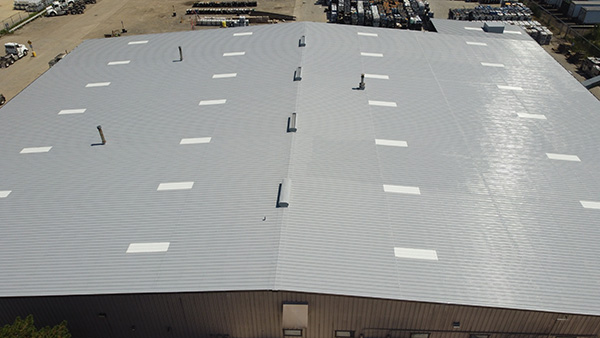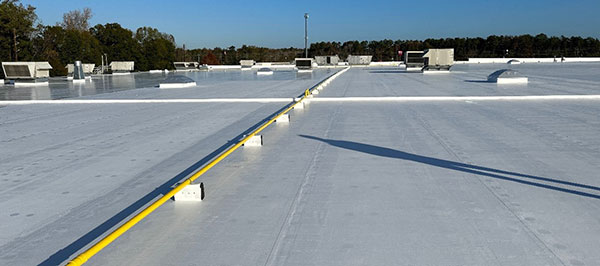Are you weighing restoration options for your commercial roof — and trying to decide between silicone and acrylic coatings?
Are you leaning toward acrylic because of its lower upfront cost, but wondering what that decision might cost down the road?
At West Roofing Systems, we’ve helped hundreds of building owners navigate this exact decision — and avoid costly mistakes. In this article, you’ll learn:
- The key differences between acrylic and silicone coatings
- When each performs best
- And why your contractor’s expertise may matter more than the product itself
Let’s start with the basics
Key Differences Between Acrylic and Silicone Roof Coatings
One of the most important distinctions between acrylic and silicone coatings is solids content — how much of the product remains on your roof after it dries.
- Acrylic coatings are typically around 55% solids, meaning roughly 45% of the material evaporates during curing.
- High-solids silicone coatings, on the other hand, are typically 95% solids, so nearly everything you apply stays on the roof.
This has real implications for performance and cost. To reach the same dry film thickness (DFT) that silicone can achieve in a single coat, acrylic may require two, three, or even four coats. That means more labor and more material.
💡 Solids content 101: A higher solids percentage = thicker final coverage with fewer coats.
It’s worth noting that high-build acrylics have improved coverage and reduced the cost gap — but they’re not quite at silicone levels yet.

Acrylic vs. Silicone: Side-by-Side Comparison
Here’s a simplified table to help you compare the two systems:
| Feature | Acrylic Coating | Silicone Coating |
|---|---|---|
| Solids Content | ~55% | ~95% |
| Recoat Frequency | Every 5–7 years | 10–20 years |
| Ponding Water Resistance | Fair | Excellent |
| Snow Load Performance | Poor | Strong |
| Cost per Gallon | Lower | Higher |
| Number of Coats Needed | 2–4 | Usually 1 |
| Best Use Case | Dry climates with good drainage | Wet or snowy climates, flat roofs |
When Acrylic Roof Coatings Might Cost More Over Time
Acrylic coatings are commonly marketed as a more affordable option — and in terms of initial material cost, that’s often true. But if you’re in a region with:
- Heavy rainfall
- Snow loads
- Flat roofs with standing water
…then acrylic coatings may require frequent recoats to maintain protection and warranty coverage.
For example:
- In certain situations, recoating can be required every 5 to 7 years.
- Missing a recoat deadline will void the manufacturer’s warranty.
- Each recoat typically costs around 50% of the original installation.
Over a 20-year span, these costs can add up and surpass the investment of just going with a silicone system.

When Acrylic Roof Coatings Are a Good Fit
That said, acrylic is not the enemy — and it can absolutely be a smart, cost-effective choice in the right environment.
You might consider acrylic if:
- Your building is located in a dry, warm region with minimal snow or ponding water.
- You need a lower-cost coating solution for a short-term holdover.
- Your roof has proper slope and drainage to prevent standing water.
Some newer high-build acrylics are beginning to close the gap in thickness and durability, making them even more viable in select applications.
The key takeaway? Acrylic isn’t a bad product — it’s just not the best solution for every roof.
Why Choosing the Right Contractor Matters More Than the Coating
Here’s the truth: The product you choose is only as good as the contractor who applies it.
A knowledgeable, experienced contractor will:
- Assess your roof’s condition, slope, insulation, and drainage
- Determine which elastomeric (acrylic, silicone, or urethane) makes the most sense
- Ensure the coating is applied to manufacturer’s specs — protecting your warranty
At West Roofing Systems, we never push one solution over another. Instead, we make recommendations based on your building’s actual needs, not what’s easiest or cheapest to sell.
Even the best roof coating will fail if installed incorrectly — or used on the wrong type of roof.

Making the Right Choice for Your Roof
Silicone coatings typically deliver better long-term performance on flat or low-slope roofs in wet or snowy climates, where standing water and ice are concerns.
Acrylic coatings, by contrast, may be suitable for buildings in dry, warm climates with good drainage, where long-term ponding is unlikely.
The right decision depends on:
- Your building’s climate
- Roof slope and condition
- Budget and long-term goals
- And most importantly — the experience of the contractor you hire
Next Step: Schedule a Roof Assessment
Roof restoration is a major investment — and one you want to get right the first time.
Now that you understand the pros and cons of each coating type, your next step is simple:
👉 Schedule a roof assessment with our team.
We’ll walk your roof, evaluate its condition, and provide you with an honest and transparent recommendation — so you can make a confident, long-term decision.
At West Roofing Systems, we’ve helped building owners across the country avoid costly coating mistakes — and we’re ready to do the same for you.

